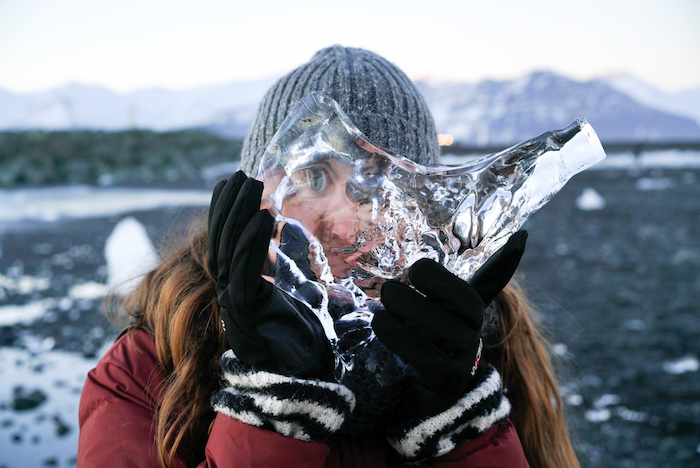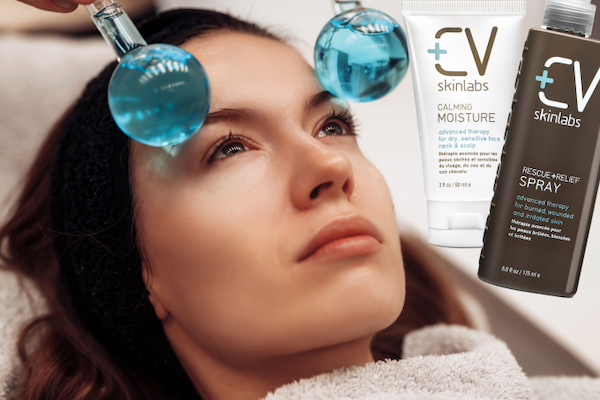
TikTok has started another beauty trend—this time, it’s facial icing.
Is this good for your skin? What if you have sensitive skin?
We explore it all below!
What is Facial Icing?
Facial icing is just what it sounds like: you put ice on your face!
You may have already been doing this—using an ice cube to reduce undereye puffiness, for example, or putting ice on your face after coming in from being out in the sun.
Indeed, celebrities have been using cold to improve their appearance for decades, applying cold cucumbers under their eyes, using ice baths before a show, or applying icy teaspoons wherever needed to improve the skin’s look.
But today’s trend is more about exposing the entire face to cold temperatures for a certain amount of time. The practice is said to provide several benefits to the skin. You can get a facial icing treatment at your local spa or esthetician’s office, or do it yourself at home using ice or other tools like frozen face rollers.
What Are the Benefits of Facial Icing?
Here are the benefits you may notice if you try facial icing.
Decreases the appearance of pores.
The cold temperature can shrink pores, making them look less noticeable for a while. Icing tones the face, making the skin (and foundation) look smoother.
Reduced redness and swelling.
Ice soothes inflammation—as you know from icing injuries—and can help tame redness and reduce swelling and puffiness.
Brighten the complexion.
Icing can give you a temporary glow, making your skin look more radiant.
Reduces inflammation.
As mentioned above, ice can help tame inflammation, which can help reduce swelling and redness, and may also help treat conditions like acne and rosacea.
Exfoliates.
If you get serious and go for a cryofacial—a professional icing treatment—it can help remove the outer layer of dead skin cells and stimulate the growth of new ones underneath.
Tames acne breakouts.
Ice reduces the swelling and redness of a pimple or group of pimples, and may soothe irritated skin.
Reduces excess oil.
If you have oily skin, you may notice after a few icing sessions that your skin is more balanced.
Prepares the skin for makeup.
It can be very effective to ice your skin before applying your makeup. It reduces the appearance of pores and tightens the skin so that makeup goes on more smoothly.
May improve the health of the skin overall.
Proponents of facial icing say that the more often you do it, the better your skin will look and feel.
Is Facial Icing Okay for Sensitive Skin?
Facial icing is safe for most people, but some people may notice more negative than positive effects.
If you have sensitive skin, be careful with icing. You may find that it leaves your skin red and irritated, or that it makes it feel dehydrated and dry. If your skin is reactive, it may also cause redness and inflammation.
Icing may be a bad idea if you have broken capillaries on your face—little spider webs of red lines. The ice may make them worse and slow healing. Those with rosacea should be cautious if the condition is triggered by cold temperatures.
Finally, avoid icing while recovering from facial procedures like cosmetic surgery, laser treatments, or peels until your skin completely heals.
What Not to Do when Facial Icing
Though facial icing is pretty easy, some side effects may be associated with the procedure if you do it the wrong way. Avoid the following mistakes.
Leaving it on too long.
If you leave the ice on your face for too long in any one place, you may suffer an ice burn. This is like a minor form of frostbite. The cold slows blood flow to the area, which deprives the skin of oxygen. The skin and the underlying tissues may be damaged.
Instead, never apply ice directly to the skin. Always wrap a cloth around it, and don’t leave an ice cube on any one area for too long.
Dunking your whole face in a bowl of ice.
Some fans of facial icing do this—some celebrities, too—but that doesn’t mean you should, particularly if you have sensitive skin. It could cause irritation and redness.
Icing too often.
The general recommendation is to ice no more than once a day. (A few times a week may be better.) If you ice too often, you could experience negative effects.
Icing after you apply makeup.
It’s best to have clean skin before you ice. Otherwise, you may press makeup, dirt, and debris into the pores.
In some cases, you may want to apply a moisturizer after cleansing to allow your ice or icing tool to roll smoothly over the skin.
How You Can Do Facial Icing
If you’d like to try facial icing yourself, talk to your dermatologist or esthetician about a treatment, or follow these tips for icing at home. As mentioned above, always start with clean skin.
When icing all over your face, a typical recommendation is to spend about 15 minutes. If you’re focusing on a singular area, stop once the skin feels really cold. After icing, apply your serums and moisturizers to leave skin feeling its best.
Try an ice massage.
Wrap an ice cube in a thin cloth, then lightly massage your entire face. Rub the ice around in a circular movement. Don’t let the ice rest on any area for too long, as it could cause irritation and redness.
Ask about a nitrogen treatment.
Your esthetician may have a cryotherapy treatment available. This uses vaporized nitrogen to cool the skin of the face, scalp, and neck area. The technician uses a hose that pumps the vapor out and onto your skin. The hose is moved quickly and held far enough away that it won’t damage the skin.
Note that it’s important to have an experienced technician perform this procedure. If you have dark skin, ask if the treatment is right for you, as there is a higher risk for discoloration in those with darker skin or a tan.
Use beneficial cubes.
You can make your own skin-beneficial ice cubes by freezing aloe vera juice or cucumber juice in an ice tray. Then use these ice cubes to give your skin an extra dose of calming, moisturizing treatment.
Use an ice roller.
There are various beauty tools like ice rollers and globes that you can store in the refrigerator and then use on your face.
Ice rollers are small, handheld skincare tools that have a handle and a roller on the top. You put it in the refrigerator or freezer, then roll it over your face for 10-20 minutes or so. (It’s best to apply a moisturizer first. A generous dose of refrigerated, cooling Rescue + Relief Spray works great!
Use an ice globe.
Ice globes are handheld glass tools (often called “wands”) with a spherical end filled with liquid. You chill them in the refrigerator or freezer overnight, then use them to reduce redness, puffiness, dark undereye circles, and to minimize the appearance of pores. You can also use them to reduce inflammation and treat pain and irritation.
To use an ice globe, apply a moisturizer or serum to the face first. We recommend our Calming Moisture. Then massage the product over your skin with smooth, outward movements to get the most benefit and create seriously radiant, smooth looking skin.
I received a box of ice globes for Christmas and was eager to try them on my sensitive skin. I applied Calming Moisture first. After massaging with the ice globes, I spritzed my skin Rescue & Relief Spray.
I did notice smoother, brighter looking skin. I also found they were very helpful in reducing puffiness and seemed to be soothing for the short term.
Have you tried facial icing?




